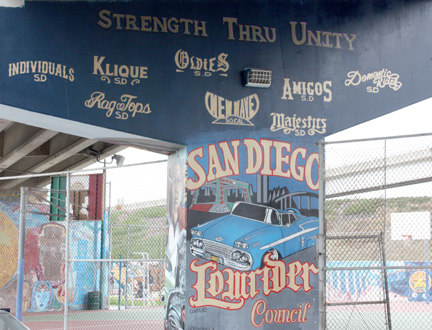Riding Low: The Birth of a Movement
Part I

The history of lowriding in San Diego is as rich as the tradition, culture, and legacy that it was founded upon. Lowriding, which started in the late 1930’s, early 40’s in California by Chicano youth, first began as a style of dress that was commonly expressed through the flamboyant, llamativo threads of Zoot Suiters. The lavish, smooth, sleek, and cool style of clothes was eventually translated into the cars, which had once been out of economic reach for most working class families.
At the end of World War II, which sparked a boom in the automotive industry, Chicano and African American youth began to accent their unique styles of dress with the customized lowrider car, restored from throwaway car and plane parts. One of the trademarks of the lowrider, which set it a part from other styles of cars was that, they were made to drive slow and ride low by cutting the coils or weighing it down with sand bags, or cinder blocks. These innovative cars, much like the Zoot Suiters themselves, defied the trends, image and attitudes of mainstream America.
From its inception, the lowrider, a term, which refers to the cars and the people who drive them, was deemed inferior and widely dismissed by the dominant society. The beauty of the lowrider culture is that in spite of the many negative stereotypes placed on it, and constantly reinforced through the media, it continues to survive and evolve as a legitimate and respected art form that is practiced both nationally and internationally.
California’s pioneering cities have paved the way for lowriders from younger generations to continue to define themselves, refine their skills, and see themselves as members of a community rooted in solidarity, and self-determination. San Diego is no exception. In fact San Diego’s lowrider community has made important strides in helping to ensure that a positive image of the lowrider culture, as well as its old school traditions, are preserved.
One of the ways this has been achieved is through the creation of the San Diego Lowrider Council. The Council, founded in 1979 by 14 San Diego car clubs, along with the support of community-based organizations, was the first ever of its kind to exist in the country. In addition to promoting a positive image of lowriding to the public, the Council helps to promote unity and solidarity amongst organized clubs.
One of the founding members of the Lowrider Council, community activist, and former President of Amigos Car Club, Rigo Reyes knows firsthand the history and evolution of lowriding in San Diego. Rigo has witnessed the challenges, changes and transformation of San Diego lowriding for over 35 years. In 1977 Rigo and a close group of friends established Amigos in order to instill the values of the old school. The foundation of the club is based on history, culture and tradition.
It is hard to know for certain who started the first lowrider car club in San Diego, what is widely accepted is that the first clubs appeared in the mid 1960’s. Some of San Diego’s pioneering clubs are Latin Lowriders, Nosotros, and Brown Image. The total number of lowrider car clubs, which have existed since the 60’s is hard to determine because not only are clubs not officially recorded, many of them are no longer active. Rigo says that, “Organizing and keeping a club together is one of the most difficult things to do. Conflicts and frictions make it or break it.”
Rigo remembers the conflicts that were common amongst car clubs in the past and says the Council became key in helping clubs communicate and diffuse tension, which is not uncommon in any type of organization. The human aspect of operating a lowrider club, Rigo says, can be challenging when it comes to electing positions and making sure everyone embraces the club’s vision and mission. He acknowledges that being a member of a club means accepting that it is not about the individual, it is about the collective. Rigo asserts, “Many car clubs are founded without the members being able to grasp what it truly means to run an organization.” For every fifty car clubs that Rigo has seen established, only five or six survive.
What is not uncommon, Rigo says, is for an inactive club to be reestablished 10-15 years later by the next generation, which shows a commitment to carrying on the legacy of their ancestors. While the clubs vision and mission may evolve with the new generation, what gives Rigo and other lowriders from the old school a great sense of pride is to see the flags of Latin Lowriders waving at car shows, reminding the next generation that the tradition lives on.
Next week Part II: Riding Low: For the Love of Low-riding.
Sherehe Yamaisha Roze is an independent consultant, educator, researcher, author, and visual/performing artist.






